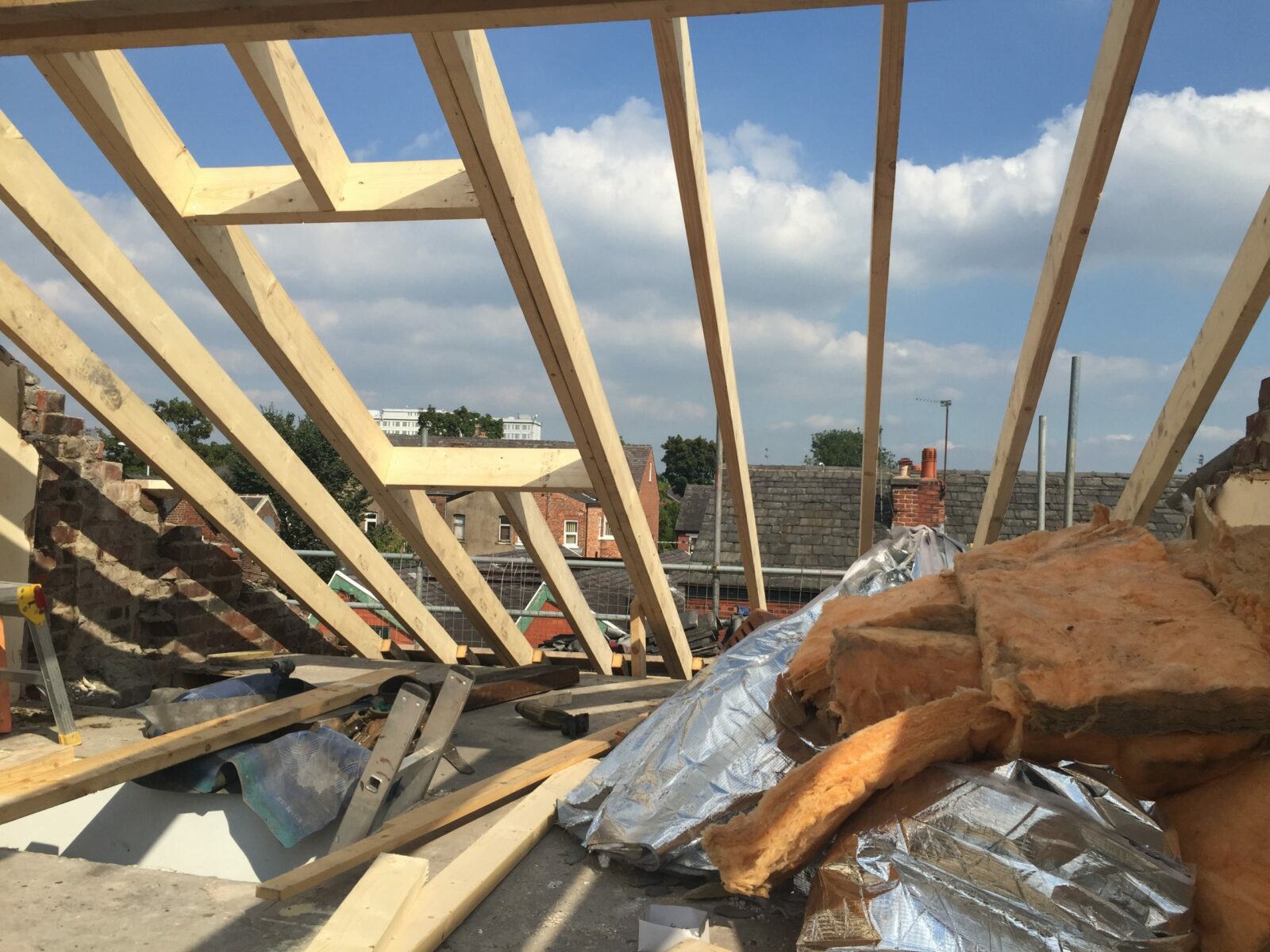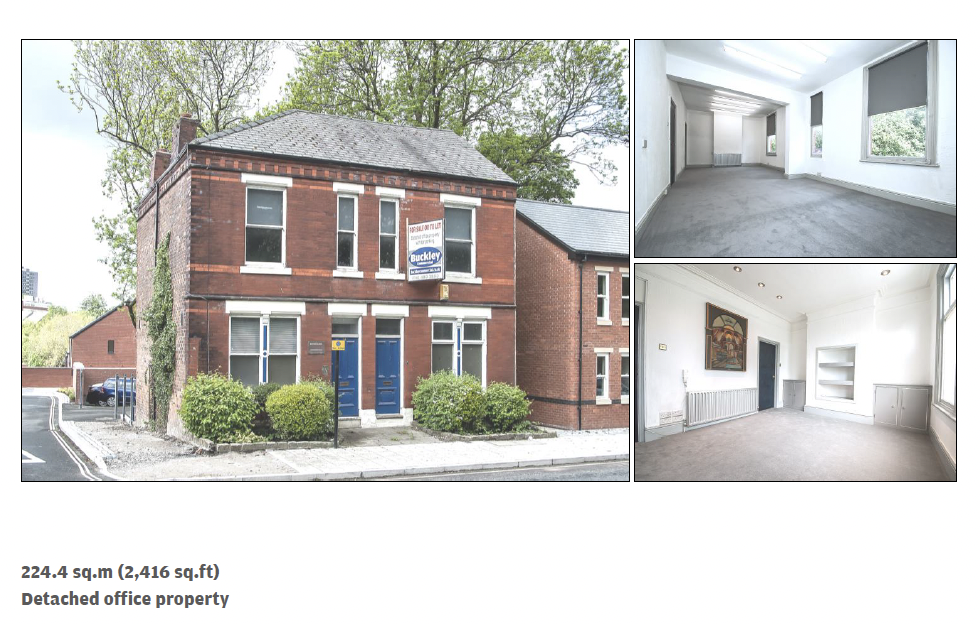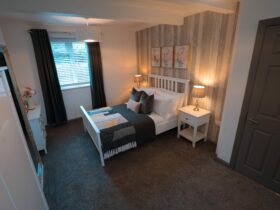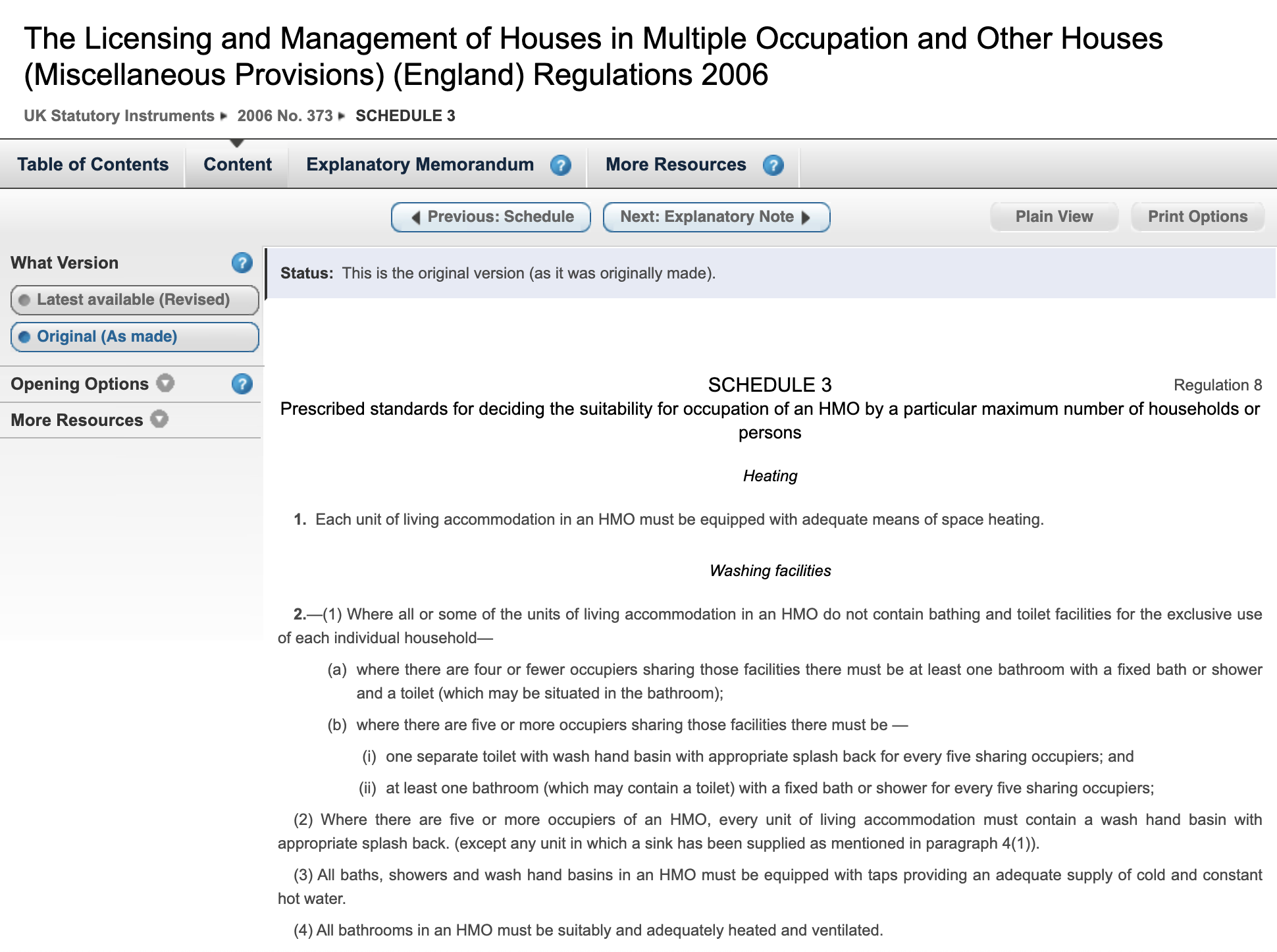HMO Project Overview
As part of HMO month here at Inside Property Investing, we look at the details of one of our projects. We asked you what you really wanted to see and it was pretty unanimous, actually, that you wanted to take a deep dive into our first HMO project.
So, you can expect to see a few things in this case study that we don’t actually do anymore. But it will be interesting (hopefully!) for you to see the learning process and the results of this now. This was our first HMO project in 2014 after I (Mike) left the corporate world. So it was an attempt to replace my income and help us on our way to replacing Victoria’s too. We’d done some flips in the past and had an unofficial HMO – my first flat in Newcastle. This was our first foray into being official HMO investors.
Tell Us About the Project/ Strategy
It was a repossessed two-bedroom terraced property in Stockport that we bought for £95,000, in a reasonable area. It wasn’t somewhere that was a hotspot or up and coming at the time, but it was a reasonable area full of rows of red brick terraced properties and fairly common of the northwest housing stock. We knew that HMO was the strategy we were aiming for, as we knew it was the highest income we could generate per square metre of property.
As I’d already left my job, we needed to make an income quickly in as short a time as possible.
The big appeal for me was that it was fairly cheap and one of the cheapest properties to come on the market in that area at the time. We didn’t have a huge amount of money, so it was crucial to get a good deal. We were budget conscious and wanted to have as much as possible to spend on the renovations.
It had actually been used as a cannabis farm. In fact, we only very recently went back in and converted the cellar last year. Up until that point, there were still watering schedules and notes on the walls! The wiring had all been done to bypass the metre, so it was an interesting project.
So, What Attracted You to the Property?
Our approach has always been to buy the worst houses we can find and add the most value to them. This was no exception to that. We wanted to be able to refinance after the renovations were complete and get as much of our cash back out as possible. If we are going to be ripping walls out and doing loft conversions anyway, then it doesn’t matter whether it’s painted nicely or there are nice radiators – it’s all got to go! The fact that this was a shell was actually really appealing. Add that it was one of, if not the cheapest, house on the market in the area – it had loads of potential.
It ticked the boxes because we knew we could get a good layout in there. We ended up doing a loft conversion and a single-storey rear extension. We also knew, as I was renting a house-share in Stockport at the time, that there weren’t that many options for young professionals out there.
What Gave You Confidence That This Property Would Work As a HMO?
Getting it at a good price was a big part of it. We had a pretty good idea of what money would come out of it. There was some concern about what would happen to the area as a secondary location and not a city centre. We weren’t 100% sure whether there would be enough demand. But, ultimately, we felt hopeful that we could make the money we wanted to from it.
When I first moved to Stockport, I moved into a HMO as Victoria was still living in Newcastle. I’d seen, therefore, what the market was like and it was okay. But it was very much full of magnolia boxes and nothing very exciting. My own experience of trying to find somewhere nice to live and there not being a huge amount on the market is what gave me the confidence that this would work. I knew that if I was looking for something, then other people must have been looking for it too. From a fundamental point of view, Stockport is very close to Manchester city centre, so you’ve got that commuter connection. There is a large volume of people in the immediate area, and where there is a volume of people, there is a need for a diversity of housing.
How Did You Source the Deal?
It was on the market with an estate agent who we had bought a flip through in the past, so we had one specific contact in the area. She knew what we were looking for. She knew we were looking for a house that we could add value to and maybe extend a little bit. However, she didn’t know that we were going to make it a HMO or know what the end result was going to be.
But crucially, she knew the outline of what we wanted. She made us aware that the property had just come on the market, although it was in pretty bad condition. Offers need to be kept in the public domain for 28 days with repossessed properties. So, there was a bit of breath-holding while we waited to find out if our offer had been accepted.
It’s how we source most of our stuff, even to this day, through the open market and estate agents. We don’t do a huge amount of off-market, direct to vendor sourcing. Our view has always been that there is enough stock on the open market to find a couple of good deals a year. Which, essentially, is all that most people in the business are looking to do.
Do You Think This Project is Fairly Typical of People Starting Out in HMO Investing?
Yes, I do! We’ve watched a lot of people start their own portfolio and I see the same struggles and mistakes come up time and time again. Trying to figure out how much renovations should cost, or where to find good builders. Wondering if they’re paying too much for the property, or how to calculate what the end value will be. There are so many moving parts to any property project, but with HMO’s they’re another step-up from single-lets or flips.
But, on the plus side, once you get through all of those questions and uncertainty (or let us guide you through it), the profit potential is phenomenal. This is a great example of a house making over £1,000 per month, which is not uncommon. But, even smaller four-bedroom mini-HMOs, where a lot of people start out, will generate in excess of £500 net-per-month.
How Did You Finance the Property?
We had some of our own money for the deposit, but we then got bridging finance for the renovations because the property was in such a bad condition. We knew we needed to do so much work to it that a conventional mortgage wouldn’t have been possible. This was the first project that we borrowed finance from a private investor as well, aside from our friends and family.
There’s an interesting story there, actually. Now we are borrowing money from investors more frequently, it’s typical to pay 6-10% interest per year. With this one, somebody had advised us that we would be able to get interest from private investors to help fund the renovations. We had a little bit of money left over after the deposit, but not a lot and needed about £40,000.
Somebody said to get in touch with some investors we’d spoken to previously and ask them about making a loan.
To prove that no one would want to invest in me, I offered 20% interest per year. I sent an email out to a dozen people and low and behold, three of them came back and said they’d take our 20%. We honoured it and it cost us £8,000 in interest, which felt painful at the time, but the reality is that the house makes us in excess of £1,000 per month. As a result of this, the investor was paid back well within the first year.
It taught us a lot about working with investors, but it’s also that opportunity cost aspect too. Had we not borrowed that money and had we not paid that £8,000, yes we would have saved the cost of interest, but we wouldn’t have a HMO today making us in excess of £1,000 per month for the foreseeable future.
Get two of them and you’ve replaced the average UK salary!
How Much Work Was Required to Turn it Into a HMO?
It was generally quite straightforward, but there was a lot of work. The whole place had to be rewired and re-plumbed and, of course, we did a ground floor extension and a loft conversion as well.
The ground floor extension allowed us to increase the size of the kitchen and communal space at the rear of the house. This meant we had enough space left over to have a bedroom and bathroom on the ground floor. Without the extension, we probably wouldn’t have been able to fit in that bedroom. Plus, the loft included a dormer, which gave us enough space to add two bedrooms and a bathroom. The loft conversion was the most expensive element of the project, but also the most valuable. Without it, we’d have been looking at a four-bedroom house and significantly lower rent, so it was money well spent.

We were definitely naïve in thinking what we could do the work for. I think it ended up costing us about double what we expected it would. Looking back now, and considering what we spend on renovations today, we still managed to do it pretty cheaply. I think that came from having such a small budget and the fact that we realised pretty quickly we would run out of money. I was on-site labouring whenever I could and we were haggling hard with our builders. We wouldn’t do that as much now as we have a better idea of what things cost. It kind of helped us to be so naïve, as it made us haggle over everything and really source the cheapest price for all materials. It was a good learning curve.
What Challenges Did You Face?
We had one issue from a structural point of view. An architect effectively missed a steel beam detail in the loft, so that cost us a bit of delay. A lot of it was newbie mistakes, though!
Underestimating the renovation budget, underestimating how long the work would take. We almost got in trouble with the bridging lender as we tried to keep the interest costs low by going for the shortest timeframe, but actually this backfired when the project wasn’t finished or refinanced in time and we had to ask the lender for an extension.
All of these things give you a better understanding of how the market works and put you in a better position for future deals, but a lot of it can be learnt by surrounding yourself with the right information rather than having to go through the pain yourself.
What Are Your Thoughts on Learning as You Go?
I think it’s the best education that you can get, doing your own project. There are definitely things that we would differently now if we were starting again, but equally, I think going through those processes and understanding the price of a project is super helpful. Education has a place, as well, but getting started and figuring some of it out as you go definitely makes a lot of sense. You really do start to understand how the costs add up, and the value (or not) that each trade brings to a project. You get a real appreciation for the different elements and how they all fit together.
In Terms of Education, What Do You Really Wish You Could Have Known Beforehand?
I guess it would have been useful to understand more about the specifics that go into a HMO project. We’d done flips and single lets, but there are a lot of unique aspects to a HMO from a building regulations point of view and also certain design choices. Knowing to think about the best layouts, en-suites and all of those bits that are unique to HMO’s would have been useful skills to have, as we sort of overlooked them, at times. There was some overlap in our knowledge, but there were some elements of HMO’s that we didn’t have a clue about to be honest.
What Went Well?
I think just getting started and jumping right in and doing it. The education we got from that first project really emphasised that we wanted to do it long-term, despite any mistakes we made. We really do see it as the precursor to where we are today.
The experience of working with investors, again, has also led onto our continued growth. Although we didn’t do it in the best way, we learnt massively from it, and took valuable points away for the future. From a HMO point of view, we effectively took a two-bedroom house in a middle of the road area and turned it into a six-bedroom house-share. The finances on it are phenomenal and we probably rent a room out in there for close to what the house would have been rented for.
Most of our projects are in Stockport now, and it was all as a result seeing the positives of this first one.
Has the HMO Market Changed at all Now?
I think so, yes. One of the biggest questions we get is about market saturation. People are put off by how many HMO’s are out there on the market at the moment. People think the market must be dead, but what we’ve found is that the need and want for them has massively increased as well. The idea of co-living has become a more popular option due to affordability, but also because after University people still want to have the familiarity and social circle of a HMO.
It’s a convenience thing as well. We’ve got a very transient population with people wanting to move around a lot, so it appeals to people to live somewhere nice for 6 to 12 months with that flexibility that HMO’s have. Plus, people are choosing to live in house-shares for longer now too.
Has the Property Adapted Well to This?
We’ve made a few changes over the years. We’ve redecorated and re-done the kitchen after learning how best HMO kitchen layouts work.
As we said, we went back and made use of the under-utilised cellar space too. It gave us an extra lounge space, so yeah; we’ve adapted the house as we’ve become more educated. But, as we did so much fundamental core work initially, we haven’t had to do anything major.

What Would You Do Differently?
As one of our first HMO’s, we probably went a bit too far and didn’t quite achieve the right balance in bedrooms and communal living. We squeezed six bedrooms into what we would now do as a five-bedroom house – but, it still rents well. Essentially, we put in the maximise amount of bedrooms thinking this was the best way to make the most money. But, people do want more communal space to socialise in. Now, we make sure we don’t forgo that for the sake of more money. It simply leads to longer void periods and less money in the long run.
Whenever we are looking at a house to convert into a HMO today, it’s all about the balance between the number of bedrooms as a proportion against communal space. We would never lose a lounge space for the sake of getting in an extra bedroom anymore. It’s about keeping that balance right.
Any Other Thoughts?
I also wish we had bought more properties at the time in the area, and I’m often kicking myself seeing the house prices there now. I guess we were concerned about short-term fluctuations in the market there at the time, instead of stepping back and thinking about the fact that we were looking at long-term income anyway. The reality is that house prices long-term go in one direction. So economically, I wish we had made more of the opportunity. The same applies now. So, if you’re not playing the capital appreciation game and you’re looking to invest long-term in an income, as long as the income is right you can ride out the market changes.
I should be kept away from interior design too! Victoria was still in the day job so there were a few questionable cosmetic decisions. I’m good with spread-sheets and not with Dulux colour charts, but at least I’ve recognised our strengths and weaknesses now!
Source link: https://www.insidepropertyinvesting.com/our-first-hmo-six-bedroom-terrace-stockport/ by Bethan Andrews at www.insidepropertyinvesting.com






